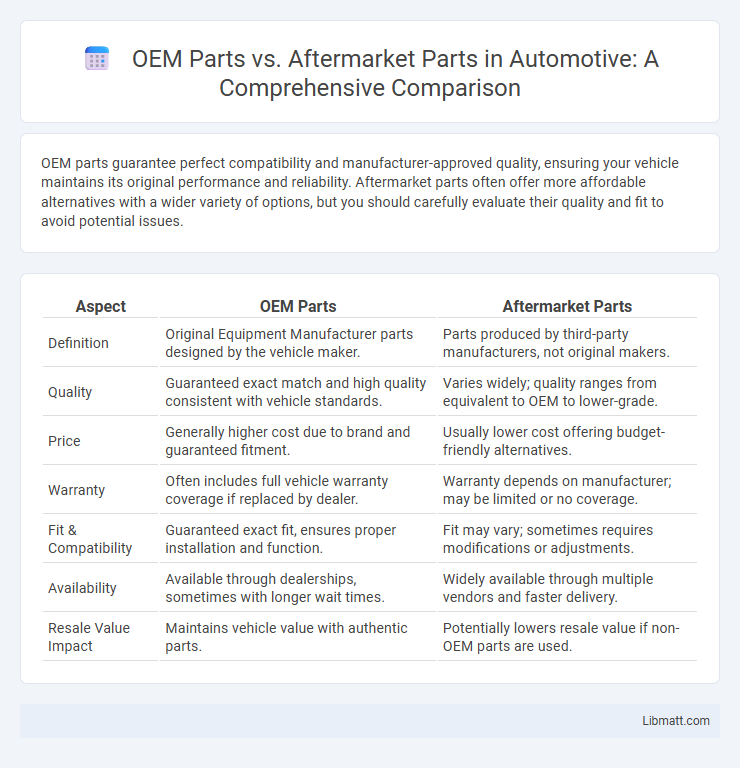OEM parts guarantee perfect compatibility and manufacturer-approved quality, ensuring your vehicle maintains its original performance and reliability. Aftermarket parts often offer more affordable alternatives with a wider variety of options, but you should carefully evaluate their quality and fit to avoid potential issues.
Table of Comparison
| Aspect | OEM Parts | Aftermarket Parts |
|---|---|---|
| Definition | Original Equipment Manufacturer parts designed by the vehicle maker. | Parts produced by third-party manufacturers, not original makers. |
| Quality | Guaranteed exact match and high quality consistent with vehicle standards. | Varies widely; quality ranges from equivalent to OEM to lower-grade. |
| Price | Generally higher cost due to brand and guaranteed fitment. | Usually lower cost offering budget-friendly alternatives. |
| Warranty | Often includes full vehicle warranty coverage if replaced by dealer. | Warranty depends on manufacturer; may be limited or no coverage. |
| Fit & Compatibility | Guaranteed exact fit, ensures proper installation and function. | Fit may vary; sometimes requires modifications or adjustments. |
| Availability | Available through dealerships, sometimes with longer wait times. | Widely available through multiple vendors and faster delivery. |
| Resale Value Impact | Maintains vehicle value with authentic parts. | Potentially lowers resale value if non-OEM parts are used. |
Introduction to OEM and Aftermarket Parts
OEM parts are original components manufactured by the vehicle's original equipment manufacturer, ensuring exact fit, quality, and compatibility with the specific make and model. Aftermarket parts are produced by third-party companies, often offering a wider range of options at varied price points but may differ in quality and fit compared to OEM parts. Choosing between OEM and aftermarket parts depends on factors like cost, warranty, performance requirements, and vehicle age.
Defining OEM Parts: What You Need to Know
OEM parts are original equipment manufacturer components produced by the same company that made your vehicle's parts, ensuring exact fit, quality, and compatibility. These parts meet the stringent standards set by the car maker, guaranteeing reliability and optimal performance for your vehicle. Choosing OEM parts helps maintain your car's warranty and preserves its resale value.
Understanding Aftermarket Parts
Aftermarket parts are components produced by third-party manufacturers that are designed to fit and function like OEM parts but often come at a lower price point. These parts can offer a wider range of options, including performance upgrades or variations not available from the original equipment manufacturer. Understanding the quality, warranty, and compatibility of aftermarket parts ensures you make informed decisions for maintaining or enhancing your vehicle.
Key Differences Between OEM and Aftermarket Parts
OEM parts are manufactured by the original vehicle maker, ensuring exact fit, quality, and warranty compatibility, while aftermarket parts are produced by third-party companies, often at a lower cost with varying quality standards. Key differences include fitment precision, warranty coverage, material quality, and price, impacting your vehicle's performance and reliability. Choosing between OEM and aftermarket parts depends on balancing cost efficiency with the need for guaranteed compatibility and long-term durability.
Pros and Cons of Choosing OEM Parts
OEM parts guarantee precise fit and optimal performance as they are made by the original manufacturer, ensuring high reliability and compatibility with your vehicle. However, these parts often come at a higher cost and may have limited availability compared to aftermarket alternatives. Choosing OEM parts supports maintaining your vehicle's warranty and long-term value but can limit options for customization or cost savings.
Advantages and Drawbacks of Aftermarket Parts
Aftermarket parts often provide cost-effective alternatives to OEM parts, offering increased availability and a wider selection for customization. However, these parts may vary in quality and compatibility, potentially leading to reduced performance or fitment issues. Choosing aftermarket parts can save your money, but it's essential to research brand reputation and warranty coverage to ensure reliability and safety.
Cost Comparison: OEM vs Aftermarket Parts
OEM parts typically cost more due to their manufacturer-certified quality and exact fit for specific vehicle models. Aftermarket parts offer a more affordable alternative, often priced 20-60% lower, though quality and compatibility may vary. Choosing between OEM and aftermarket hinges on budget constraints and the desired balance between cost savings and guaranteed performance.
Quality and Reliability: Which Parts Are Better?
OEM parts are manufactured by the original equipment maker, ensuring exact specifications, superior fit, and consistent reliability that matches the vehicle's original performance standards. Aftermarket parts can vary widely in quality, with some offering competitive performance and cost savings, while others may lack durability or compatibility. For maximum quality and long-term reliability, OEM parts generally provide better assurance due to rigorous testing and manufacturer warranties.
Warranty and Support Considerations
OEM parts typically come with manufacturer-backed warranties that match your vehicle's original specifications, ensuring optimal performance and peace of mind. Aftermarket parts may offer varied warranty coverage, often shorter or less comprehensive, which can affect long-term reliability and support. Choosing OEM parts can provide you with consistent warranty protection and direct support from the vehicle maker, safeguarding your investment.
Making the Right Choice: OEM vs Aftermarket Parts
Choosing between OEM and aftermarket parts requires assessing factors such as quality, cost, and compatibility. OEM parts guarantee exact specifications and reliability, matching the original components used by the vehicle manufacturer, while aftermarket parts vary widely in quality and can offer cost savings. Evaluating warranty coverage, performance standards, and long-term durability helps ensure the right choice for maintenance or repair needs.
OEM parts vs Aftermarket parts Infographic

 libmatt.com
libmatt.com